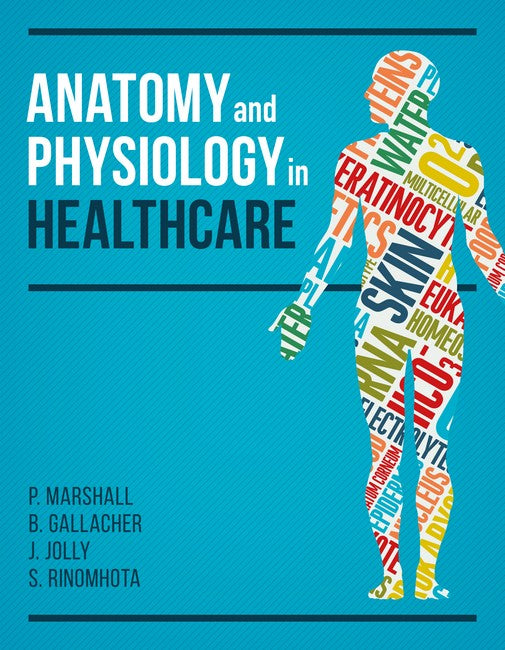Description
01. Why is the human body the way it is? 1.1 Introduction and clinical relevance 1.2 What you need to know - essential anatomy and physiology 1.2.1 Why the human body is the way it is 1.2.2 Single-celled and multicellular organisms 1.2.3 Homeostasis and homeodynamics 1.2.4 The internal environment and plasma 1.2.5 The homeodynamic process 1.2.6 The homeodynamic regulation of body temperature 1.3 Clinical application 1.4 Anatomical language 1.4.1 General anatomical terms 1.4.2 Body cavities 1.4.3 Body regions 1.5 Summary 1.6 Further reading 1.7 Self-assessment questions 02. Cells and their environment 2.1 Introduction and clinical relevance 2.2 What you need to know - essential anatomy and physiology 2.2.1 Types of cell: the diversity of life 2.2.2 Components of a eukaryotic cell 2.2.3 Organization of cells in the body 2.3 Clinical application 2.4 Summary 2.5 Further reading 2.6 Self-assessment questions 03. Genetics: how cells divide and introduce variation 3.1 Introduction and clinical relevance 3.2 What you need to know - essential anatomy and physiology 3.2.1 The genome 3.2.2 Chromosomes 3.2.3 Cell division 3.2.4 Application of genetics to healthcare 3.3 Clinical application 3.4 Summary 3.5 Further reading 3.6 Self-assessment questions 04. Communication: short and fast 4.1 Introduction and clinical relevance 4.2 What you need to know - essential anatomy and physiology 4.2.1 Characteristics of a biological communication system 4.2.2 The nervous system: structural organization 4.2.3 Nervous tissue 4.2.4 Functional organization of the nervous system 4.2.5 The generation and propagation of an action potential 4.2.6 The central nervous system: the brain and spinal cord 4.2.7 Neuronal pathways and tracts of the brain and spinal cord 4.2.8 Protection and nourishment of the brain and spinal cord 4.2.9 The peripheral nervous system (cranial nerves and spinal nerves) 4.2.10 The autonomic nervous system 4.3 Clinical application 4.4 Summary 4.5 Further reading 4.6 Self-assessment questions 05. Communication: long and slow 5.1 Introduction and clinical relevance 5.2 What you need to know - essential anatomy and physiology 5.2.1 The endocrine system 5.2.2 Protein hormones 5.2.3 Lipid-derivative hormones 5.2.4 How hormones exert an effect 5.2.5 Major endocrine glands and tissues 5.3 Clinical application 5.4 Summary 5.5 Further reading 5.6 Self-assessment questions 06. How the external environment is interpreted 6.1 Introduction and clinical relevance 6.2 What you need to know - essential anatomy and physiology 6.2.1 Sensation and perception 6.2.2 Vision and the eye 6.2.3 Taste and smell 6.2.4 Hearing 6.2.5 Touch 6.3 Clinical application 6.4 Summary 6.5 Further reading 6.6 Self-assessment questions 07. Why food is needed: the chemical basis of health 7.1 Introduction and clinical relevance 7.2 What you need to know - essential anatomy and physiology 7.2.1 The driving force behind cellular processes and activities 7.2.2 Components of food 7.2.3 Making nutrients in food available 7.3 Clinical application 7.4 Summary 7.5 Further reading 7.6 Self-assessment questions 08. The importance of water and electrolytes 8.1 Introduction and clinical relevance 8.2 What you need to know - essential anatomy and physiology 8.2.1 Water and electrolytes 8.2.2 Functions of the kidney 8.3 Clinical application 8.4 Summary 8.5 Further reading 8.6 Self-assessment questions 09. Organs need to be perfused 9.1 Introduction and clinical relevance 9.2 What you need to know - essential anatomy and physiology 9.2.1 Structure and function of blood vessels 9.2.2 Blood flow and perfusion 9.2.3 The heart: structure and function 9.2.4 Blood pressure 9.2.5 Blood composition and function 9.3 Clinical application 9.4 Summary 9.5 Further reading 9.6 Self-assessment questions 10. The body needs oxygen 10.1 Introduction and clinical relevance 10.2 What you need to know - essential anatomy and physiology 10.2.1 Upper respiratory tract 10.2.2 Lower respiratory tract 10.2.3 Lung tissue and the bronchial tree 10.2.4 Ventilation and the mechanics of breathing 10.2.5 Respiratory volumes and capacities 10.2.6 Exchange and transportation of gases 10.2.7 Regulation of breathing by chemoreceptors 10.3 Clinical application 10.4 Summary 10.5 Further reading 10.6 Self-assessment questions 11. Protection from harm 11.1 Introduction and clinical relevance 11.2 What you need to know - essential anatomy and physiology 11.2.1 Lymphatic structures support immunity 11.2.2 Innate immunity - physical defences 11.2.3 Recognition of microorganisms by innate immunity 11.2.4 Innate immunity - cellular defences 11.2.5 Innate immunity - humoral defences 11.2.6 Acute inflammation 11.2.7 Adaptive immunity 11.3 Clinical application 11.4 Summary 11.5 Further reading 11.6 Self-assessment questions 12. Skin: our protective cover 12.1 Introduction and clinical relevance 12.2 What you need to know - essential anatomy and physiology 12.2.1 Structure of the skin 12.2.2 Factors affecting the skin 12.2.3 Wound healing 12.3 Clinical application 12.4 Summary 12.5 Further reading 12.6 Self-assessment questions 13. Achieving movement 13.1 Introduction and clinical relevance 13.2 What you need to know - essential anatomy and physiology 13.2.1 Bones 13.2.2 The joints 13.2.3 Muscles 13.3 Clinical application 13.4 Summary 13.5 Further reading 13.6 Self-assessment questions 14. From one generation to the next 14.1 Introduction and clinical relevance 14.2 What you need to know - essential anatomy and physiology 14.2.1 Structure and function of the male reproductive system 14.2.3 Structure and function of the female reproductive system 14.3 Clinical application 14.4 Summary 14.5 Further reading 14.6 Self-assessment questions

